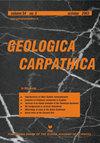Formal definition and description of lithostratigraphic units related to the Miocene silicic pyroclastic rocks outcropping in Northern Hungary: A revision
IF 1.5
4区 地球科学
Q4 GEOSCIENCES, MULTIDISCIPLINARY
引用次数: 5
Abstract
Repeated explosive eruptions of large volume silicic magmas during the earlyto mid-Miocene resulted in pyroclastic deposits covering at least 50,000 km2 in the Pannonian Basin. They form extended marker horizons and therefore these pyroclastic formations have a great stratigraphic importance. Lithostratigraphic characterization and classification of these rocks go back for more than a century and have been used widely in geological mapping among other things. In this paper, we outline the former stratigraphical schemes developed for silicic pyroclastic products in Northern Hungary; however, using the new geochronological, volcanological, petrological, and geochemical results, we propose a revision of the lithostratigraphic units, including the unit names as well. Four main units are distinguished, named, and described following the International Stratigraphic Guide. Stratotypes of the revised units were also redefined based on accessibility and representativeness. The four newly-defined lithostratigraphic units are the following: (1) The Tihamér Rhyolite Lapilli Tuff Formation (formerly Gyulakeszi Fm.), 18.2–17.1 Ma (Ottnangian–Karpatian); (2) The Bogács Dacite Lapilli Tuff Formation (formerly classified into the Tar Fm.), 16.8–16.2 Ma (Karpatian); (3) The Tar Dacite Lapilli Tuff Formation, 15.1–14.8 Ma (Badenian) and (4) The Harsány Rhyolite Lapilli Tuff Formation, 14.7–14.4 Ma (Badenian) – four formerly existing formations merged in the latter. Three of these units have corresponding distal volcanic products recognized around Hungary and beyond the Pannonian Basin as well. A correlation of the scattered volcanic products can be made based on lithological characteristics, as well as the chemical composition of glass shards, juvenile clasts, and zircon.匈牙利北部出露的中新世硅化火山碎屑岩岩石地层单位的正式定义和描述:修订
中新世早期至中期,大量硅化岩浆的反复爆发导致潘诺尼亚盆地的火山碎屑沉积面积至少为50000平方公里。它们形成了扩展的标志层,因此这些火山碎屑岩地层具有重要的地层意义。这些岩石的岩石地层特征和分类可以追溯到一个多世纪前,并在地质测绘等方面得到了广泛应用。本文概述了匈牙利北部硅化火山碎屑产物的地层方案;然而,利用新的地质年代、火山学、岩石学和地球化学结果,我们提出了对岩石地层单位的修订,包括单位名称。根据《国际地层指南》对四个主要单元进行了区分、命名和描述。修订单位的地层类型也根据可及性和代表性进行了重新定义。新确定的四个岩石地层单元如下:(1)Tihamér Rhyolite Lapilli-Tuff组(原Gyulakeszi组),18.2–17.1 Ma(Ottnagian–Karpatian);(2) Bogács Dacite Lapilli-Tuff组(以前属于Tar组),16.8–16.2Ma(Karpatian);(3) Tar Dacite Lapilli-Tuff组,15.1–14.8 Ma(巴登尼亚)和(4)Harsány Rhyolite Lapili-Tuff层,14.7–14.4 Ma(巴登尼亚)——四个以前存在的地层合并在后者中。其中三个单元在匈牙利周围和潘诺尼亚盆地以外都有相应的远端火山产物。根据岩性特征以及玻璃碎片、新生碎屑和锆石的化学成分,可以对分散的火山产物进行对比。
本文章由计算机程序翻译,如有差异,请以英文原文为准。
求助全文
约1分钟内获得全文
求助全文
来源期刊

Geologica Carpathica
地学-地球科学综合
CiteScore
2.40
自引率
23.10%
发文量
26
审稿时长
>12 weeks
期刊介绍:
GEOLOGICA CARPATHICA covers a wide spectrum of geological disciplines including geodynamics, tectonics and structural geology, volcanology, stratigraphy, geochronology and isotopic geology, karstology, geochemistry, mineralogy, petrology, lithology and sedimentology, paleogeography, paleoecology, paleobiology and paleontology, paleomagnetism, magnetostratigraphy and other branches of applied geophysics, economic and environmental geology, experimental and theoretical geoscientific studies. Geologica Carpathica , with its 60 year old tradition, presents high-quality research papers devoted to all aspects not only of the Alpine-Carpathian-Balkanian geoscience but also with adjacent regions originated from the Mediterranean Tethys and its continental foreland. Geologica Carpathica is an Official Journal of the Carpathian-Balkan Geological Association.
 求助内容:
求助内容: 应助结果提醒方式:
应助结果提醒方式:


